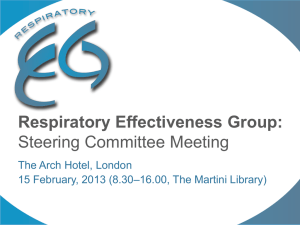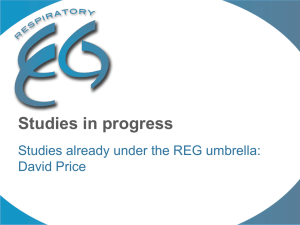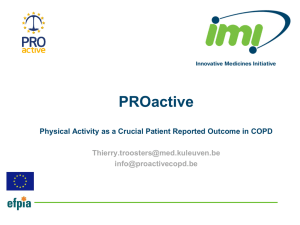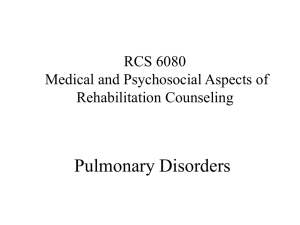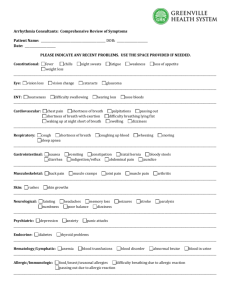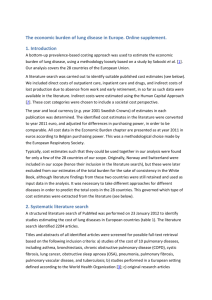Model of learning technologies
advertisement
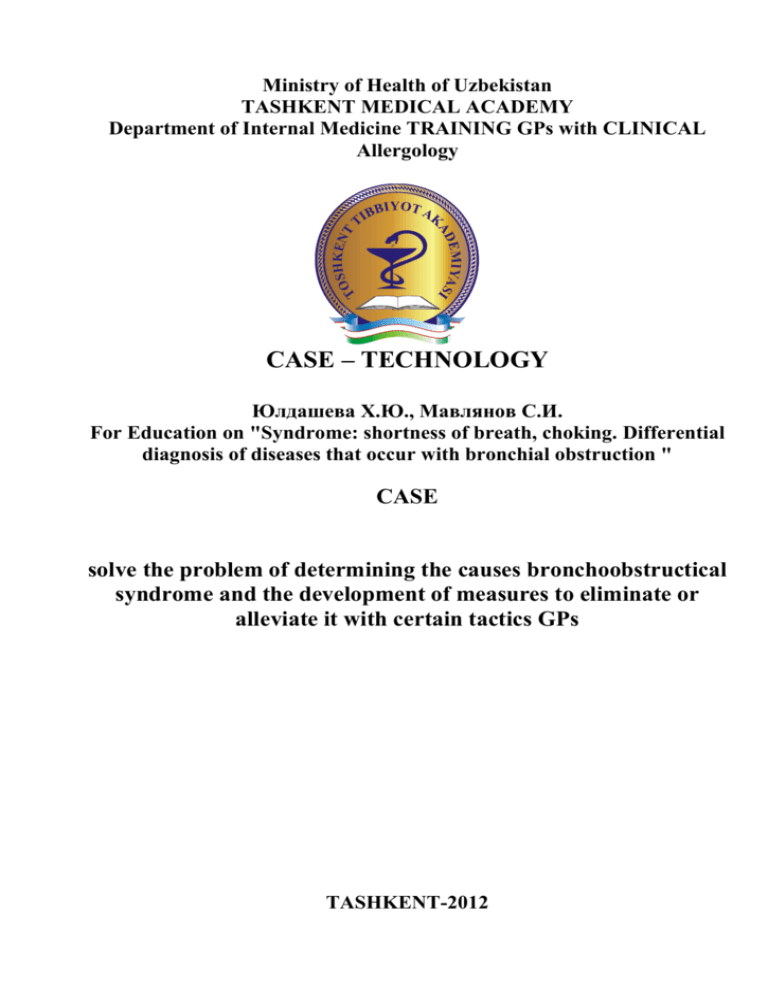
Ministry of Health of Uzbekistan TASHKENT MEDICAL ACADEMY Department of Internal Medicine TRAINING GPs with CLINICAL Allergology CASE – TECHNOLOGY Юлдашева Х.Ю., Мавлянов С.И. For Education on "Syndrome: shortness of breath, choking. Differential diagnosis of diseases that occur with bronchial obstruction " CASE solve the problem of determining the causes bronchoobstructical syndrome and the development of measures to eliminate or alleviate it with certain tactics GPs TASHKENT-2012 2 Ministry of Health of Uzbekistan TASHKENT MEDICAL ACADEMY Department of Internal Medicine TRAINING GPs with CLINICAL Allergology CASE - TECHNOLOGY For Education on "Syndrome: shortness of breath, choking. Differential diagnosis of diseases that occur with bronchial obstruction " CASE solve the problem of determining the causes bronhooobstruktivnogo syndrome and the development of measures to eliminate or alleviate it with certain tactics GPs ТАШКЕНТ – 2012 3 CASE TECHNOLOGY for Education on "Shortness of breath, choking. Differential diagnosis of diseases that occur with bronchial obstruction (asthma, COPD, and lung tumors). Tactics GPs. case teaching abstract The subject: Internal Medicine Section: "Shortness of breath, choking" Topic: "The differential diagnosis of diseases that occur with bronchial obstruction (asthma, COPD, and lung tumors). Tactics GPs. Course: 6th year of the medical faculty The purpose of this case: deepen and broaden students' knowledge of diseases involving BOS syndrome, their classification, the development of practical skills in analyzing the situation and make informed decisions in the presence of wheezing, breathlessness. Skills select tactics, diagnosis, emergency care. Expected learning outcomes: for performance with case students learn how to: - Evaluation and assessment of the practical situation and the general condition of the patient; -informed decision-making in the differential diagnosis of diseases associated with shortness of breath, choking; - Selecting the right algorithm for the diagnosis of action - Self-emergency care when necessary, to the hospital for treatment. For the successful resolution of the case study students should have knowledge of the pathogenesis, etiology, risk factors, diseases associated with shortness of breath, choking, their classification, clinical presentation, diagnostic criteria and differential diagnosis, the main survey methods and principles of therapy. This case reflects the artificial situation. The object is a case study in COPD (personality). Sources of information case: 1.Убайдуллаев А.М.., Нафас органлари касалликлари. » нашриёт-матбаа акциядорлик компанияси бош мухаририяти. Тошкент – 2004 й. 2.Путов Н.В., Федосеева Г.Б. Руководство по пульмонологии. Ленинград ”Медицина” Ленинградское отделение 1984 г. 3.Чучалин А.Г. Хронические обструктивные болезни легких. Москва, ЗАО «Издательство БИНОМ» 2000 г. 4.Туев А.В., Мишланов В.Ю. Бронхиальная астма (иммунитет, гемостаз, лечение). Пермь 2001 г. 5.Баранов В.Л., Куренкова И.Г., Казанцев В.А., Харитонов М.А. Исследование функции внешнего дыхания. «Элби-СПб» Санкт-Петербург 2002 г. 6.Чучалин А.Г., Абросимов В.Н. Кашель (патофизиология, клиническая интерпретация, лечение).Рязань, 2002 г. 7.Добротина И.С. Диагностика и лечение бронхообструктивного синдрома. Издательство НГМА, Нижний Новгород, 2002 г. 8.Убайдуллаев А.М. Функциональные методы диагностики в пульмонологии. Ташкент – 1997 г. 9.«Умумий амалиёт врачлари учун маърузалар туплами» /А.Гадаев. 2010. 4 10.«Умумий амалиёт врачлари учун амалий куникмалар туплами» /А.Гадаев, Х.Ахмедов. 2010. 11.«Критерий пошаговой оценки медицинского консультирования студентов с учетом синдромального подхода» /А.Г.Гадаев. 2008. 12.Нормативные документы по деятельности сельского врачебного пункта/1-часть. //Ташкент 2009. 13.Энциклопедия клинического обследования больного // Денисов И.Н., Ивашкин В.Т., Княжев В.А. и др. 2001. 14.Общая врачебная практика по Джону Нобелю//М. 2005. Дополнительная 1.Воробьева И.И. Двигательный режим и лечебная физкультура в пульмонологии. Москва, Медицина.,2000 г. 2.Тейлор Д. “Трудный диагноз”. М., 1995 г. 3.Хеглин Р. “Дифференциальная диагностика внутренних болезней”. Медицина 1997 г., 8-том. 4.Денисов И.Д. Энциклопедия клинического обследования больного, ГЭОТАР, Москва, Медицина.,1998 Characteristics of case study according to the typological features: This case is classified as a desk, scene. It is short, structured questionnaires, contains a set of facts. For didactic purposes Case refers to illustrate the problem, training analysis and assessment, make informed decisions. Case presented in print. Case can be used to discipline internal medicine. CASE "Shortness of breath, choking" Introduction. The majority of patients with dyspnea and suffocation, particularly in chronic obstructive pulmonary disease (COPD) and bronchial asthma (BA) to seek medical help. In this situation, the force of a general practitioner (GP) is directed to the diagnosis of COPD and asthma. In the case of COPD or asthma GPs must determine the severity of the disease, it is necessary to determine the causes of exacerbation of the disease to provide medical care, clarify locations of this group of patients and plan preventive measures and medical examination. On practical training in the theoretical part series discusses the clinical features of diagnosis of COPD, asthma, lung tumors. COPD - a distinct disease (nosological form) is the final stage of the progressive course of COB, the stage at which the disease progresses is lost due to the reversible component of airway obstruction and pulmonary hypertension develops. Chronic obstructive pulmonary disease (COPD) is one of the leading causes of morbidity and mortality in the adult population. The predominant age - over 40. Predominant sex - male. Etiology and risk factors: smoking - inhibits the function of alveolar macrophages, which destroys the lung surfactant, slow transport of mucus, increases the release of lysosomal enzymes. The adverse effects of the environment (including professional). A-antitrypsin deficiency - increases the sensitivity of lung tissue to autolyze own proteases and leads to the destruction of the walls of the alveoli, ie to the progression of emphysema. Frequent viral infections. Alcohol abuse. COPD refers to a group of diseases multigeneticheskih. 5 The main risk factor (in 80-70% of cases) COPD - smoking. Smokers have the highest mortality rates, they quickly develop irreversible obstructive changes in respiratory function, and all of the known symptoms of COPD. It is believed that the demography of bronchial obstruction in COPD reflects the prevalence of smoking. COPD is a chronic inflammatory process appears with a primary lesion of the distal airways. For this category of patients is characterized by reduction in peak expiratory flow rate and a slow gradual deterioration of pulmonary gas exchange function, which reflects the irreversible airway obstruction. Biomarkers of chronic inflammation in COPD are involved with elevated neutrophil myeloperoxidase, elastase, an imbalance in the systems of proteolysis-antiproteolizoxidants and antioxidants. The main clinical manifestations of COPD are cough varying severity, sputum production and shortness of breath. COB allocation as a separate nosological form is crucial from the point of early diagnosis and treatment under Reg reversible component of airway obstruction, ie if there is a real possibility inhibition of disease progression by affecting the reversible component. The clinical picture of COPD depends on the stage of the disease, the rate of progression of the disease and the priority level of the lesion bronchial tree. COPD develops in terms of the risk factors slowly and progresses gradually. The rate of progression and severity of COPD symptoms depend on the intensity of the influence of etiological factors and their summation. The first sign that patients usually go to the doctor, is a cough and shortness of breath, sometimes accompanied by wheezing with phlegm. These symptoms are most pronounced in the morning. The earliest symptoms that to 40-50 years of life, is a cough. By this time in the cold seasons are beginning to have episodes of respiratory infection, does not bind to the first one disease. Shortness of breath, initially perceived exertion, there are on average 10 years after the appearance of cough. Sputum production in a small number (rarely more than 60 ml / day) in the morning, has a slimy character and becomes purulent only during infectious episodes, which are usually regarded as an exacerbation. As the progression of COPD exacerbations spacing becoming shorter. Results of the physical examination of patients with COPD depends on the degree of airway obstruction, the severity of lung hyperinflation and physique. As the disease progresses to coughing joins wheezing, most notable for rapid exhalation. Often auscultation revealed raznotembrovye dry rales. Shortness of breath may vary very widely: from a sense of lack of air at standard physical exercise to severe respiratory failure. As the progression of airflow obstruction and lung hyperinflation increase anteroposterior size of the chest rise. Limited mobility of the diaphragm, auscultation picture changes: reduced the severity of wheezing, prolonged exhalation. Sensitivity of physical techniques to determine the severity of COPD is low. Among the classical symptoms include wheezing breath and elongate expiration (> 5 sec), which may indicate bronchial obstruction. Thus, the development and progression of COPD occurs in times of risk factors characterized by a slow gradual onset. The first (the earliest) COPD is a sign of a cough. Other characters join later in the progression of the disease, with a gradual acceleration of the disease progression. Physical examination in patients with COPD is not enough for a diagnosis of the disease, it provides a benchmark for the future direction of the diagnostic studies using instrumental and laboratory methods. Conventionally all diagnostic methods can be divided into methods of mandatory minimum, used in all patients (general analysis of blood, urine, sputum, chest radiography, the study of respiratory function (ERF) and ECG), and additional methods used for special indications. 6 For clinical work with patients with COPD, in addition to general clinical tests recommended ERF study (FEV1, forced vital capacity and vital capacity) test with bronchodilators (b2agonists and holinolitikami), chest X-ray. The remaining methods are recommended for special indications, depending on the severity and nature of its progression. In everyday practice, patients with COPD used tests with bronchodilators (b2-agonists and / or holinolitikami), which to some extent the ability to fast regression of bronchial obstruction, in other words, a "reversible" component of obstruction. The increase in FEV1 during the test by more than 15% from baseline values are commonly characterized as a reversible obstruction. Tactics GPs. 1. Smoking cessation and limitation of external risk factors. 2. Patient education. 3. Bronchodilatory therapy. 4. Mukoregulyatornaya therapy 5. Antiinfective therapy. 6. Correction of respiratory failure. 7. Rehabilitation therapy. In forming the strategy and tactics of treatment of patients with COPD is crucial to allocate two regimens: treatment without exacerbation (maintenance therapy) and treatment of COPD exacerbations. Asthma. Chronic inflammatory disease of the airways characterized by bronchial hyperreactivity, a common reversible bronchial obstruction. The leading role in inflammation belongs eosinophils, mast cells and lymphocytes. The prevalence of the disease, 3% of the total population, up to 7% - in children. Predominant sex children under 10 years old, male, adults - women. Risk Factors Heredity Allergens products house dust mites, mold spores dander, hair, fibers dried saliva and urine of domestic animals, bird feathers, food and drug allergy, smoking (active and passive). Provocateurs (triggers) BA. Infectious (usually ARI) Air pollutants-SO2, NO2, etc. Exercise. Pungent smells. Cold air. Admission B-blockers. Sinusitis. Gastro - esophageal reflux. Clinic-choking or difficulty breathing, expiratory dyspnea, cough, tachycardia, dry wheezing, worse on the exhale and listens as auscultation, and at a distance (eg, remote wheezing), percussion - box sound (gipervozdushnost lung tissue) . Classification of asthma. Etiologic Predominantly allergic - atopic asthma. Non-allergic asthma. Mixed asthma. Unspecified asthma. 7 Depending on the severity. Mild intermittent (episodic) form less than one attack per week, nocturnal symptoms at least 1 time per month, short relapse (from several hours to several days), normal lung function in the interictal period FEV1 and peak Volumetric expiratory flow (PIC) is greater than 80% predicted, variations PIC 20%. Mild persistent form - symptoms more than 1 time per week, but not daily, nocturnal symptoms more than 3 times per month, the exacerbation can disrupt activity and sleep, the PIC and / or OFV1st more than 80% of predicted, variations POS to 30%. Moderate to severe persistent form - daily symptoms, nighttime symptoms more than 1 time per week, acute violate activity and sleep, daily use of inhaled B-agonists, PIC, FEV1 60 to 80% of predicted, variations PIC-20-30%. Severe persistent form - persistent symptoms and frequent exacerbations, frequent nocturnal symptoms, limitation of physical activity, POS and / or FEV1 less than 60% predicted, variations PIC over 30%. Special forms of asthma. Aspirin-intolerant characterized by aspirin and other NSAIDs, as well as products containing natural salicylates, manifested severe asthma, until the development of asthma status, often associated with recurrent polypous rhinosinusitis. Asthma in pregnancy Laboratory - instrumental investigations. KLA-eosinophilia, sputum microscopy - is dominated by eosinophils, crystals Charcot Leyden, spiral Kurshmana. Pikfluometriya - reducing PIC below 80% of normal for the patient's values. Spirometry - reduced FEV1 below 80% of normal for the patient znacheniy.Obratimost obstruction-PIC iOFV1 increase after administration of bronchodilators by 15% or more. Skin tests - positive for certain allergens. Chest X-ray - gipervozdushnost lung tissue Tactics GPs. Eliminating or limiting exposure to allergens and triggers. Diet - hypoallergenic. Patient education, monitoring the condition, the frequency of use of an inhaler and other drugs. Treatment of exacerbations. Clinical supervision. Drug therapy Bronchodilators-B2-agonists: short (fenoterol, salbutamol, in acute and prior to exposure to the provoking factors) and long-acting (salmeterol, Volmax, to prevent attacks, including night, anticholinergics, Atrovent (ipratropium bromide), berodual (combined preparation of fenoterol and Atrovent) in severe bronhoree to treat an attack; methylxanthines, aminophylline in / or / m-acute attack, drugs theophylline sustained release (teotard, teopek etc.) inward to prevent nocturnal attacks. Anti-inflammatory therapy GCS-inhalation-beclomethasone dipropionate, Flixotide, etc., in / in and inside-prednizalon dexamethasone. Membrane of mast cell stabilizers (cromolyn sodium, nedocromil sodium, ditek-inhalation, ketotifen and others in the table., To prevent attacks. Leukotriene receptor-zefirlukast, montelukast. Theoretical survey can be carried out using the "Brainstorming" 8 The method of "Brainstorm" Purpose: This method is used to stimulate the exchange of ideas, increases the degree of involvement of the participants, teaches argue and defend their point of view, to find the best solution in this situation. The teacher asks students questions about the activity: 1. Define the term "chronic obstructive pulmonary disease" (COPD) and asthma. 2. Tell classification of COPD and asthma. 3. List the diagnostic criteria for COPD and asthma. 4. List the laboratory and instrumental methods for the diagnosis of COPD and asthma complications and diseases. 5. Give predispose to the development of COPD and asthma factors. 6. Differential diagnosis of asthma and COPD. 7. Tell wording diagnosis of COPD. 8. List the treatment during acute exacerbations of COPD and beyond and BA. 9. Tell clinical manifestations, laboratory and instrumental methods of diagnosis and complications of lung tumors. Answer: 1. COPD - primary chronic inflammatory disease, mainly affecting the distal airways of the lung parenchyma and the formation of emphysema and is characterized by airflow limitation with the development of an irreversible (or not fully reversible) bronchial obstruction caused by persistent productive nonspecific inflammatory response. The disease is manifested by coughing, sputum and increasing shortness of breath, has been steadily progressive nature of the outcome of the chronic respiratory failure and pulmonary heart. BA-disease, which is based on airway inflammation, accompanied by changes in the sensitivity and bronchial reactivity and manifested asthma, status asthmaticus, or, in its absence, respiratory discomfort (paroxysmal cough, wheezing and shortness of distance), accompanied by reversible airflow obstruction against the hereditary predisposition to allergic diseases, extrapulmonary symptoms of allergies, blood eosinophilia and / or eosinophils in the sputum. 2. Recommended classification of COPD severity with the release of four stages is given in accordance with the latest version of the international program "Global Initiative for Chronic Obstructive Lung Disease» (GOLD, 2003). Classification of COPD severity (GOLD, 2003) Stage The main clinical signs Functional indicators I: light cough, sputum production, usually, but not always. • FEV1/FVC (IT) <70% 80% of the predicted value II: Moderate • Persistent cough, most pronounced in the morning, scanty sputum usually, but not always Shortness of breath on mild exertion • FEV1/FVC (IT) <70% FEV1 <80% predicted value. 9 III: severe persistent cough, sputum, shortness of breath • IT <70% • 30% <FEV1 <50% predicted value. IV: Very Severe cough, sputum, shortness of breath • IT <70% • FEV1 <30% predicted value or FEV1 <50% predicted value in combination with chronic right heart failure or NAM Note: FEV1 - forced expiratory volume in 1 s, FVC - forced vital capacity Classification of asthma sm.teoreticheskuyu part. Examples of formulations diagnosis: A) COPD mainly bronhitichesky type, moderate flow (stage II), remission or exacerbation, MD B) COPD, predominantly emphysematous type, very heavy flow (stage IV), remission or exacerbation, NAM III, chronic pulmonary heart, the degree of heart failure. The purpose of this case study is to deepen and broaden the students' knowledge of the issues of timely diagnosis for shortness of breath, choking, caused asthma, COPD or lung tumors, the development of practical skills in analyzing the situation and make informed decisions on the management and treatment of COPD, asthma. The solution proposed case study will allow students to achieve the following learning outcomes: - Develop skills in analysis of practical situations, the ability to select the right algorithm for the diagnosis of action Ability to work off-informed decision-making in patients with COPD and asthma; - Develop clinical reasoning. Situation. An appointment with a GP, accompanied by relatives turned 32 years old patient with complaints of asthma is difficult to breath when entering the cold air, rising from the bed and nervous tension, cough with difficult scanty sputum, weakness, insomnia. From history-sick for 20 years, as a child hives and shortness of breath when going out of town. Asthma attacks in the past 10 years. Exacerbation of the disease is often in the spring and early summer. Suppresses seizures inhaled salbutamol, aminophylline injection, is in "D" account. In the last 3 months of frequent attacks, 1-2 times a week at night worried. Works as a shop in the grocery store. Smoked 6 years, in the last 5 years does not smoke.'s Mother and brother allergodermia. An objective examination: moderate condition, the position of orthopnea, cyanosis of the lips, hands, breathing with minor muscle and extended expiration. Over light percussion lung sounds of the boxed color. Auscultation: a weakened vesicular breathing, scattered dry wheezing. Heart sounds are muffled, accent II tone of the pulmonary artery. Pulse 88 in 1 min. Blood pressure 120/70 mm Hg. Abdomen soft and painless. Regular chair. The liver was not enlarged. Diuresis b / o. Symptom effleurage negative on both sides. KLA. 7% monocytes, 7%, ESR 16 mm / h OAM. 0.033% 0 protein, leukocytes 1-2/1, 0-1/1 epitope, erythema 0-1/1. 10 Sputum-character-mucosa, leukocytes-1-2, alveolar macrophages - 3-4, eosinophils, 7-8, Charcot-Leyden crystals, spiral Kurshmana, BC and abnormal cells - no. LHC. Sugar 5.3 mmol / L, total cholesterol 5.5 mmol / L, ALT 0.3 mmol / L, AST, 0.2 mmol / L, bilirubin 13.1 mmol / L, creatinine 0.05 mmol / L, urea 7.2 mmol / l. Coagulation. PTI 85%. Fibrinogen 300 mg%. ECG revealed sinus rhythm, correct. HR 88 v1min. EOS denied the right, P-pylmonalae. Incomplete right bundle branch block. Chest X-ray - lung fields promoted luchepronitsaemosti, Questions and tasks: 1.On your opinion, what abnormalities to make a differential diagnosis? 2.What to the emergence of this disease? 3.Vash diagnosis. Justify it. 4.Specify tactics GP. A training material for students: "Differential diagnosis of COPD and asthma" COPD - primary chronic inflammatory disease, mainly affecting the distal airways of the lung parenchyma and the formation of emphysema and is characterized by airflow limitation with the development of an irreversible (or not fully reversible) bronchial obstruction caused by persistent productive nonspecific inflammatory response. The disease is manifested by coughing, sputum and increasing shortness of breath, has been steadily progressive nature of the outcome of the chronic respiratory failure and pulmonary heart. BA-disease, which is based on airway inflammation, accompanied by changes in the sensitivity and bronchial reactivity and manifested asthma, status asthmaticus, or, in its absence, respiratory discomfort (paroxysmal cough, wheezing and shortness of distance), accompanied by reversible airflow obstruction against the hereditary predisposition to allergic diseases, extrapulmonary symptoms of allergies, blood eosinophilia and / or eosinophils in the sputum. Framework for the diagnosis of any disease with bronchial obstruction is a well-built and well conducted anamnesis. In unclear cases a sputum and respiratory functions, test with bronchodilator. Tactics of diagnosis determines the sequence of the following schematic to address key issues: the identification of risk factors, determining the intensity and duration of their impact on patients, especially allergoanamneza, onset than provoked by shortness of breath, choking, whether they are paroxysmal in nature or not, what complications are attached, the changes identified in the laboratory and instrumental examination of the patient, bronchial obstruction and the degree of reversibility. II. Methodical instructions student The problem: determination of the cause of bronchial obstruction and development of measures to eliminate or alleviate it with certain tactics GPs. Instructions for independent work in the analysis and solution of practical situations. № 1. 2. Stages of work Recommendations and advice First, read the case studies. Familiarization with case Reading, Do not try to analyze the situation. Once again, read the information. Highlight those paragraphs that seemed important to you. List the Acquaintance with a given factors set forth in the description of the event. situation. Try to describe the situation. Identify what it important and what is secondary. 11 3. 4. 5. 6. Trying to understand the wealth of information available to you, "do not drown" in it, try to identify the main. Identification, creation and Problem: The determination of the cause of study key issues and sub- bronchial obstruction (RF, the allergens that problems. trigger Factors irritants) and development activities and to facilitate the relief of breathlessness, suffocation with certain tactics GPs. Diagnostics and analysis When analyzing the situation, answer the following questions: 1. Disease, the main clinical symptoms are shortness of breath and asthma? Much different pathogenesis, clinical bronchial obstruction at them? 2. What risk factors contribute to the development of COPD, asthma, lung tumors? 3. Which diagnostic methods must be applied, make a plan and justify the level survey hovercraft or SP, CRH? 4. What specialized diagnostic methods are necessary to confirm the diagnosis? 5. Determine whether emergency aid. 6. The basic principles of non-drug and drug treatment of COPD, asthma. 7. Diagnosis and service category for a given situation? Selection and justification of ways and means to solve the problem. Development of measures for implementation of the proposed resolution of the problem situation. List all the possible ways and means of addressing the situation. Put diagnosis. Develop measures to eliminate the risk factors and identify methods of dealing with them. Solve the problem in a hovercraft, joint venture or a specialized department of the clinic. Instructions for group work to analyze and solve practical situation. Stages of work Recommendations and advice Reconciliation of the situation and the problem. Discuss and agree on various representations of the group members about the situation, the problem and the subproblems. Discuss and evaluate the proposed options and ways to address the problem. Select the priority, in your opinion, the idea of solving the problem. Analysis and evaluation of the proposed methods and means of solving problems, the choice of priority the idea to solve the problem. Develop mutually acceptable solution to the problem and detailed design implementation. Prepare a presentation Develop a mutually acceptable solution to the problem and the detailed design implementation. Make the results in the form of an oral 12 presentation on behalf of the group. Discuss and decide the question of who will represent the results of the group work: the leader of the whole group, or with the division between the participants (co-reports), depending on the tasks to be solved by them in the course of analyzing and solving problems. Prepare illustrative materials in the form of posters, slides or multimedia. In the preparation of reports, especially mark the rough outline of what you say, do not go into the details! Sheet analysis and problem solving The name of the stage with a The content of work stage briefcase Acquaintance with a given situation Review given the particular situation and in a case determination essential to solving the problem of information. When analyzing the situation, answer the following questions: The situation analysis 1.How disease is most often accompanied by shortness of breath, asthma. 2. Risk factors for COPD. 3.For what disease is characterized by a history of allergic reactions? 4.Faktory risk of asthma in this patient. 5. For what disease is characterized by springsummer season of acute illness? 6.Stepen effective bronchodilator therapy. 7.Naibolee informative methods are needed to confirm the diagnosis, and which ones can be realized in a hovercraft and SP. 8.How do more consultation is needed for a final diagnosis? substantiation is Choice of alternatives addressing Development and justification of solution Justification of the problem and its key components. Formulation of alternatives solutions situational problem. Detailed development and justification of a particular decision. 13 Table assessment of individual work with case The Evaluation criteria and indicators participants Analysis of the current Substantiation situation is max 0,5 max 1,0 Detailed Choice of development methods and of measures The overall means of to score addressing implement (max 2,5) * max 0,5 the decision max 0,5 1. 2. № * 2.0 - 2.5 points - "excellent", 1.5 - 2.0 points - the "good" 1.0 - 1.5 points - "satisfactory" less than 1.0 points - "unsatisfactory" The evaluation system options group decision problem. 1. Each group is given two evaluation points. It can give them all at once to one embodiment of the decision or split into two (1:1 0,5:1,5, etc.), not including the assessment of their own solutions. 2. All the scores for each alternative solutions are added. The winner is the solution with the highest number of points. In disputed cases, you can take a vote. Table evaluate options group decision problem, the score Groups Alternative solutions to problems 1 2 3 № 1. 2. № total Оценка презентации предлагаемого решения Group Completen ess and clarity of presentatio n (1 - 20) Visibility of representat ion of the universe of presentatio n (1 - 20) Mass susceptibi lity and activity of members of the group (1 20) Originalit y proposed decision (1 - 20) Admissibility of the legislative standards (1 - 20) The total amount of points (max 100) 14 1. 2. № Option III solutions case study teacher-keysolog 1. What range of common diseases, accompanied by shortness of breath, asthma. • COPD • Asthma • Lung Tumors • PE • Pulmonary tuberculosis • Heart failure • Spontaneous pneumothorax • bronchiectasis • Pneumoconioses 2. Which diagnostic methods should be applied? Plan Survey by categories 3.1 and 3.2. • History • blood pressure, pulse, temperature • These physical examination (Systems) • ECG, KLA, OAM, • Pikfluometriya • General analysis of sputum, sputum culture • Coagulogram, hematocrit • The gas composition and acid-base balance of blood • Chest X-ray • Spirography • Bronhodilyatatsionny test • allergy tests • echocardiography, Lecture dif.diagnoz. Given these situational problems - asthma, when entering the cold air, exertion, seasonal exacerbations, the presence of risk factors, physical examination findings (wheezing) is necessary to differentiate between asthma, COPD, lung tumors. Non-pharmacological treatment. Medication. IV. Case Study Technology for practical training. Model of learning technologies Theme: Number of hours - 6.5 Form of studies: Plan Workshops: Differential diagnosis of dyspnea in patients with COPD and asthma, asthma and lung tumors Number of students - 9. Exercise increase knowledge of asthma and COPD, practical skills and determination of the patient tactics 1. 1. Introduction to the training 15 The purpose of the training session: Tasks the teacher: - To consolidate and deepen the students' knowledge about the differential. diagnosis of asthma and COPD, to develop students' skills of self-informed decision-making for shortness of breath and choking. - To develop the skills of the patient: - A culture of debate, communication skills Teaching methods: Learning Tools: Offer Learning conditions: Monitoring and evaluation session 2. 2. actualization of knowledge 3. 3. Working with case studies in small groups 4. 4. Presentation of the results 5. 5. Discussion, evaluation and selection of the best options strategy 6. Execution skills Conclusion. Evaluation of the groups and students, the degree of achievement of lesson. Consolidation, deepening and expanding students' knowledge of the issues of timely diagnosis for shortness of breath and asthma, the development of practical skills in analyzing the situation and make informed decisions in the treatment of asthma and COPD Learning outcomes: - Classify, characterize the clinical features of asthma and COPD, explain the significance of risk factors in the development of the disease; - Analyze the situation presented in the case; - Allocate and formulate the problem, objectives, situation; - Based on the analysis of the situation to make informed decisions to resolve it activities carried out in the treatment of asthma and first aid; - Make a final conclusion, rightly defend it; - Carry out practical skills. Case studies, discussion, practical skills Case, student guidance, flip chart Individual, front, group work Audience, work with a group, a hospital ward, room Observation, quiz, presentation, evaluation Technological map of lesson Этап работы Содержание деятельности 16 Teachers Phase I - 1.1. Calls subject classes, its purpose, Introduction to objectives, and expected outcomes of training the training activities. session 1.2. Introduces the mode of operation for (10 min) employment and evaluation criteria (see guidance for students). 1.3. Explains the purpose of the case study and its impact on the development of professional knowledge. 1.4. Distributes materials case and introduces the algorithm for analysis of the situation (see guidance for students). 1.5. Gives the task independently analyze and record the results in the "List of analysis of the situation." phase II 2.1. Conducting a poll in order to enhance primary students' knowledge on the topic: 60 min. students listen record Independently study the contents of the individual case and fill the sheet of the situation. Answer questions. at the heart attack of breathlessness in asthma? asthma? final diagnosis? attacks? 2.2. Divides students into groups. Reminds Group norms and rules of debate. 2.3. Gives the task: Divided into groups. individual work with a case (situation analysis sheets) in small groups; Perform task. activities to address suffocation; entation. 2.4. Coordinates, advises, directs the learning activities. Monitors and evaluates the results of individual work: sheets of the situation. 2.5. Of the presentation on the results of the work done to address the case study, discussion and vzaimootsenki. 2.6. Comments, notes about the selected event in the analysis for the treatment of asthma. 2.7. Tells own solution. the learning 17 Groups are involved in the presentation of the results. Participate in discussions, ask questions, evaluate. 10 min 2.8. Organizes a student's skills Palpation, percussion, auscultation, conduct and interpretation of data pikfluometrii IIIetap-A Final 3.1. Sums up the lesson, summarizing the listen Assessment results of training activities, announces 10 min. evaluation of individual and collaborative work. 3.2. Stresses the importance of the case study Opine and its impact on the future specialist. 3.3 gives homework. record Example address patient presented in the case studies Situation. An appointment with a GP, accompanied by relatives turned 32 years old patient with complaints of asthma is difficult to breath when entering the cold air, rising from the bed and nervous tension, cough with difficult scanty sputum, weakness. From history-sick for 20 years, as a child hives and shortness of breath when going out of town. Exacerbation of the disease is often in the spring and early summer. Suppresses seizures inhaled salbutamol, aminophylline injection, is in "D" account. In the last 3 months of frequent attacks, 18 1-2 times a week at night worried. Works as a shop in the grocery store. Smoked 6 years, in the last 5 years does not smoke. An objective examination: moderate condition, the position of orthopnea, cyanosis of the lips, hands, breathing with minor muscle and extended expiration. Over light percussion lung sounds of the boxed color. Auscultation: a weakened vesicular breathing, scattered dry wheezing. Heart sounds are muffled, accent II tone of the pulmonary artery. Pulse 88 in 1 min. Blood pressure 120/70 mm Hg. PT. Abdomen soft and painless. Regular chair. The liver was not enlarged. Diuresis b / o. Symptom effleurage negative on both sides. KLA. 17% monocytes, 7%, ESR 16 mm / h OAM. 0.033% 0 protein, leukocytes 1-2/1, 0-1/1 epitope, erythema 0-1/1. LHC. Sugar 5.3 mmol / L, total cholesterol 5.5 mmol / L, ALT 0.3 mmol / L, AST, 0.2 mmol / L, bilirubin 13.1 mmol / L, creatinine 0.05 mmol / L, urea 7.2 mmol / l. Coagulation. PTI 85%. Fibrinogen 300 mg%. ECG revealed sinus rhythm, correct. HR 88 v1min. EOS denied the right, P-pylmonalae. Incomplete right bundle branch block. X-ray - hilar compacted lung fields promoted luchepronitsaemosti, Date: I complaints: II III IV Anamnesis morbi: Anamnesis vitae: Risk factors: V Problems VI General examination: VII The patient is 32 years old, the seller, the floor - M Index smoker - 60 -72. t0C = 36,5, Pulse 88 minutes. A / D 120/70 mm. Hg. Art. for asthma attacks with difficult breathing out when leaving the cold air, rising from the bed and nervous tension, cough with difficult scanty sputum, weakness. He considers himself a patient for 20 years, dyspnea, and rash bothered when going out of town, asthma attacks in the past 10 years. Exacerbation of the disease is often in the spring and early summer. Suppresses seizures inhaled salbutamol, aminophylline injection, is in "D" account. In the last 3 months of frequent seizures, is in the dispensary. Growing and developing in satisfactory conditions, smoked for many years, dropped out, was sick with hepatitis, hereditary, allergic and epidemic anamnesis denies. Managed: smoking, exposure to allergens, hypothermia Unmanaged: gender, age and heredity. Key: asthma, cough with difficult expectoration, wheezing with difficulty exhaling. Related: weakness, insomnia. The general condition: the state of moderate severity, location orthopnea, cyanosis of the lips, hands, breathing with minor muscle and extended expiration. Respiratory system: over light percussion lung sounds of the boxed color. Auscultation: a weakened vesicular breathing, scattered dry wheezing. CCC: border of the relative dullness of the heart were normal. Heart sounds are muffled, accent II tone of the pulmonary artery. Pulse 88 in 1 min. Blood pressure 120/70 mm Hg. Digestive organs: Abdomen soft and painless. Regular chair. The liver 19 VIII Preliminary diagnosis: Survey plan by: IX Research category 3.1: X XI Interpretatio n of clinical laboratory and instrumental experimental analysis: The differential diagnosis: XII was not enlarged. Urine: Urine output b / o. Symptom effleurage negative on both sides. No edema. Main: Asthma III level, persistent current. Complication: NAM II degree. Category 2. Category 3.1: - Professional questioning and inspection - KLA, OAM - pikfluometriya ECG -total sputum Category 3.2: - Bacteriological sputum culture with antibiotic susceptibility - X-ray methods KLA Pikfluometriya ECG Self-stepping KLA: eosinophilia - 8%, ESR-slightly increased to 15 mm / h OAM and biochemical blood tests - normal. The general analysis of sputum: dominated eosinophils, CharcotLeyden crystals, spiral Kurshmana. Chest X-ray: gipervozdushnost lung tissue. Pikfluometriya-MPV reduction (PIC) and FEV1 on spirometry data below 80% of normal for the patient's values. ECG showed sinus tachycardia, heart rate 92 in 1min., P-rulmonalae, right bundle branch block Asthma, family history, history of allergic reactions, asthma attacks, no attacks - almost healthy, seasonal exacerbations, the reversibility of bronchial obstruction, UAC - eosinophilia in sputum eosinophils predominate, are the spiral Kurshmana, Charcot-Leyden crystals. COPD - risk factors - smoking and prolonged exposure to adverse environmental factors (including professional), alcohol abuse, frequent viral infections, the predominant age over 40 years, the absence of attacks of breathlessness, in times of acute outbreaks of SARS and hypothermia, mucous and phlegm often - purulent , increased body temperature, sputum neutrophil-dominated, FVDvalues of FEV1 and PIC reduced minimum speaker after use bronchodilator. Pulmonary tuberculosis: the study of sputum revealed mycobacteria from the history prolonged contact with smear, infiltrative pulmonary tuberculosis is more often localized in the S1, S2, S6 segments of the lung. Lung cancer: for a long time without symptoms, asthma and shortness of breath worrying compression of the bronchi, may hemoptysis, weight loss, depression, anemia, changes in the diagnostic X-ray and CT scan, sputum - atypical cells, red blood cells. 20 XIII XIV Clinical diagnosis: Determined the form in which the prevention of the patient needs: Drug-free treatment Main: Asthma III stage, medium-severe persistent current. Complication: NAM II degree. Category 2. Secondary prevention and b: to identify and make an accurate diagnosis in the early stages of the disease, non-drug treatment for the disease and drug therapy of proven efficacy. Tertiary b-diagnosis complications, treatment. 1. bed rest 2. Health food - easily digestible, enriched with vitamins and proteins food 3.Lechebnaya breathing exercises 4. Prohibited from smoking and alcohol. 5. Positional drainage, chest compressions 6. oxygen therapy Medication: 1.Bronholitiki - B2 - agonists - inhalation -salbutamol (Ventolin) for 1-2 breaths - 3 times a day - M anticholinergics - atrovent inhalation, 1 inhalation 2 times a day - Theophylline (teopek, teodur and TE) 200 mg - 1-2 times a day 2. Anti-inflammatory treatment: - GCS - prednisone 60 mg -90 fiz.rastvore / drip, beklametazon inhaled - Antihistamines (suprastin, ketotifen) 3. Mucolytics - Ambrobene in tablets of 30 mg 3-4 times a day, XVI sodium bicarbonate 4% -200 ml / drip 4. Drugs to reduce pulmonary hypertension - calcium channel blockers (verapamil) Convinced of the need for patient hospitalization in a specialized XVII Spent the feedback to pulmonary department at discharge - a visit to a GP, setting the date set a date and of re-examination and investigation. Convinced of the patient's understanding of the recommendations. time of follow-up visit the patient in the joint venture or SVP to monitor the effectiveness of treatment: XVIII Took patient Group clinical supervision D3s registration, predetermined by the teamsulfur dispensary observation XV 21 XIX All types of prevention: XX Stages of clinical examination: Primary prevention - prevention of the disease: a) to promote a healthy lifestyle B) early detection of risk factors and the removal of controlled risk factors, exposure to allergens, polyutantami, occupational hazards, improving ekologiiP . Secondary prevention: a) the identification of the disease in the early stages (preventive checkups, screenings) B) timely drug and non-drug treatment of identified diseases with the use of drugs with proven efficacy. Tertiary prevention: a) timely observation of patients, prevention of acute and chronic complications, monitoring, laboratory and instrumental studies, the use of drugs with evidence, correction of risk factors, and dynamic monitoring; B) continuing treatment measures and qualitative rehabilitation of existing complications Stages of clinical examination after the final diagnosis: 1st - determine nosological form of the disease and clinical examination of the group-III-D 2nd - definition of multiplicity of observations (medical examinations) for the first year and 1 time in a month, then 1 every 3mesyatsa. 3rd - justification consultation specialists when indicated, pulmonary, tuberculosis, allergist, 1 time a year. 4th - justification multiplicity planned laboratory and other examinations for the year - the KLA and sputum, ECG one every six months, chest X-1 once a year. 5th - drawing algorithm therapeutic and recreational activities as a general practitioner for a year - in-patient treatment in a specialized pulmonary department 2 times a year, a spa treatment one time per year. LFC-regular classes. 6th - On the basis of clinical examination of the performance criteria specific patient move from one patient to another dispensary group when necessary.




